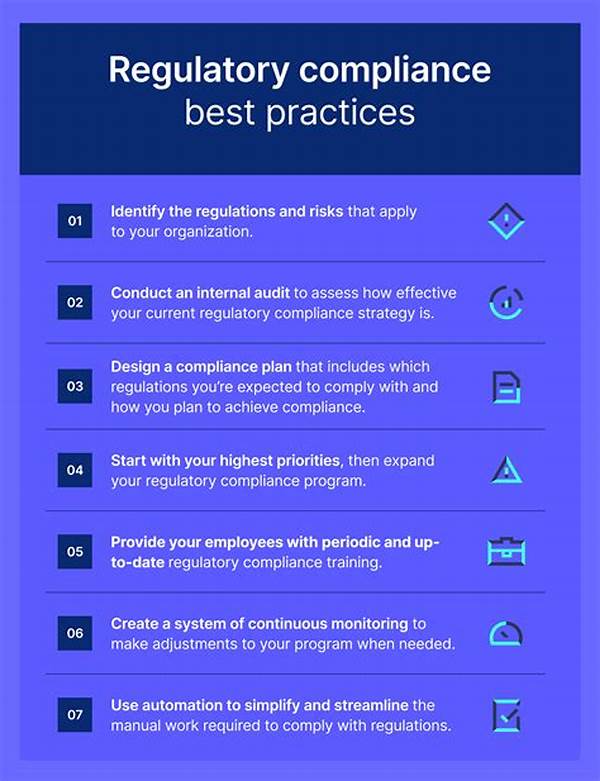In the digital age, the landscape of technology applications is ever-evolving, thereby necessitating a thorough understanding and implementation of compliance requirements for applications. These requirements are paramount in ensuring that digital solutions not only meet legal standards but also protect user data and uphold privacy. The complexities of software compliance are heightened by the diversity of legal frameworks that govern them, ranging from data protection laws to industry-specific regulations. Addressing these regulations is crucial for developers, businesses, and users alike to ensure compliance is maintained and liabilities are minimized. The following sections delve into the various facets of compliance requirements for applications, offering insights into their significance, core components, and application in real-world scenarios.
Read Now : Reducing Operational Overhead With Apis
Core Components of Compliance Requirements
Compliance requirements for applications encompass a wide range of legal, technical, and organizational mandates. Central to these requirements is data protection, which includes adherence to laws such as the General Data Protection Regulation (GDPR) and the California Consumer Privacy Act (CCPA). These laws mandate strict data handling practices to protect user privacy. Additionally, compliance involves securing applications against threats and vulnerabilities, often following standards set by organizations like the National Institute of Standards and Technology (NIST) or the International Organization for Standardization (ISO). Furthermore, industry-specific regulations may apply, such as the Health Insurance Portability and Accountability Act (HIPAA) for healthcare applications, ensuring specific data and privacy safeguards.
Security audits and regular compliance checks are also vital components. These processes evaluate the conformity of applications to established standards, identifying potential gaps or areas of improvement. Developers are required to implement robust documentation practices, ensuring transparency and traceability in the handling of data and other critical operations. Regular updates and training can assist organizations in maintaining current compliance, keeping up with evolving legal landscapes and emerging risks. Understanding these core components assists in developing secure and compliant applications, fostering trust with users, and aligning with best practices in application development.
Essential Compliance Factors
Importance of Adhering to Compliance Requirements
Adherence to compliance requirements for applications is crucial for safeguarding user data and enhancing trust. Privacy and data protection regulations are not merely bureaucratic hurdles but fundamental requirements that influence the perception of an application in the marketplace. By adhering strictly to these requirements, organizations mitigate the risk of hefty fines and legal repercussions associated with non-compliance. Additionally, compliance fosters consumer trust, which is indispensable for sustained business success. Users are more inclined to engage with applications that are transparent about their data practices and security measures.
Moreover, compliance with regulations fosters innovation by pushing organizations to integrate secure and efficient practices in application development. It ensures a uniform standard that guides developers in creating applications that are not only legally compliant but also technically sound. This presents an opportunity for businesses to differentiate themselves as leaders in security and reliability in a competitive digital environment. Therefore, compliance requirements for applications are not only instrumental in fulfilling legal obligations but also in propelling business innovation and growth.
Practical Examples
In practical terms, compliance requirements for applications manifest through various implementations:
1. Data Encryption: Implementing encryption protocols to protect user data.
2. User Consent: Ensuring applications obtain explicit user consent for data usage.
3. Access Controls: Establishing strict access controls to sensitive information.
4. Regular Audits: Conducting frequent security audits to ensure compliance.
5. Incident Management: Developing robust plans for data breach management.
6. Transparent Policies: Crafting clear user data privacy policies.
Read Now : Adaptive Authentication Strategy Development
7. Secure Development: Using secure coding practices throughout the development lifecycle.
8. Legal Support: Consulting with legal experts to interpret and implement compliance requirements.
9. User Notifications: Informing users about data policy changes.
10. Record Keeping: Maintaining detailed records of data processing activities.
Challenges and Future Directions
Navigating the challenges posed by compliance requirements for applications demands keen strategic alignment and adaptability. As technology evolves, compliance becomes increasingly complex, involving a myriad of international regulations. Organizations face challenges in harmonizing these regulations, especially when applications operate across multiple jurisdictions. Staying ahead of emerging threats and regulations requires a proactive approach, emphasizing continuous monitoring and adaptation to maintain compliance. The technological landscape is relentless, each innovation presenting new compliance challenges. Thus, fostering an organizational culture of compliance is pivotal, implicating not only developers but marketing, legal, and executive teams.
Future directions in compliance also suggest an increasing reliance on technology to support compliance initiatives. Artificial Intelligence and Machine Learning are being utilized for predictive compliance management, enhancing the ability to detect non-compliant activities proactively. Automated tools can streamline compliance processes, reducing human error and improving efficiency. The path forward in compliance also calls for stronger collaboration across industries and nations, fostering mutual understanding and standardization of regulations. Thus, while compliance requirements for applications pose significant challenges, they also present avenues for collaboration and technological advancements.
Conclusion and Reflection
In conclusion, compliance requirements for applications constitute an indispensable aspect of modern application development and deployment. They offer businesses a strategic advantage by ensuring applications meet legal standards, thus minimizing risks and enhancing user trust. Compliance supports a transparent relationship between users and applications, mitigating potential legal and financial repercussions that may arise from breaches or non-compliance. Businesses that prioritize compliance are better positioned to build a reputable brand that resonates integrity and reliability within the digital landscape.
Equally, the evolution of compliance requirements is a testament to the dynamic nature of technology and law. They are no longer seen merely as constraints but as catalysts for innovation and growth. As the digital environment continues to expand, staying ahead of compliance requirements will necessitate ongoing education and adaptation. The interplay between compliance mandates and technological innovations will consistently redefine the boundaries of application development, ensuring a secure and trustworthy digital ecosystem.
